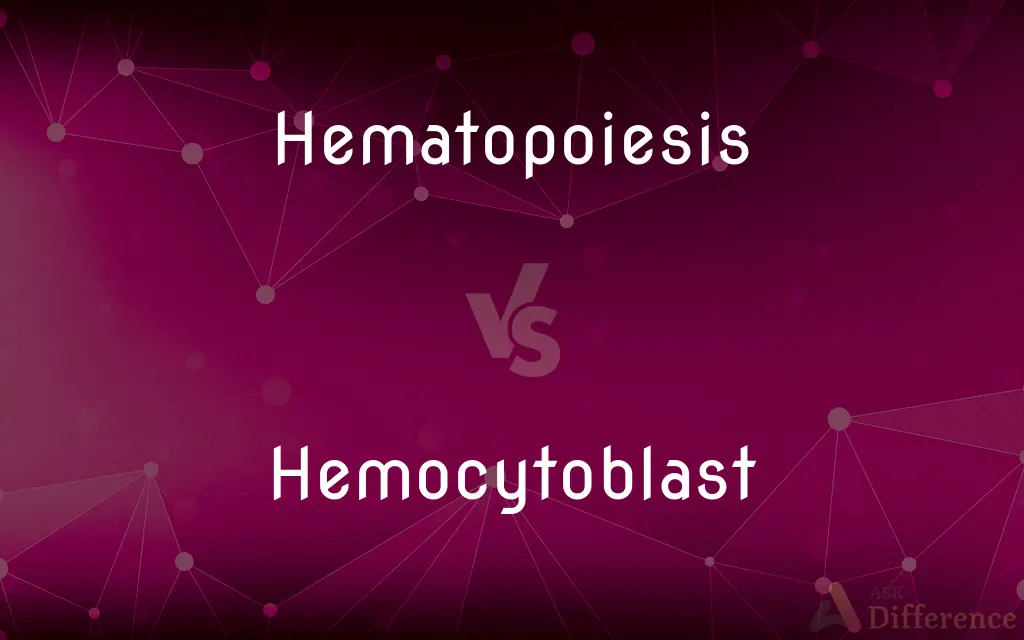Hematopoiesis vs. Hemocytoblast — What's the Difference?
By Fiza Rafique & Maham Liaqat — Updated on May 15, 2024
Hematopoiesis is the process of blood cell production in the body, while a hemocytoblast is a type of stem cell that initiates this process.

Difference Between Hematopoiesis and Hemocytoblast
Table of Contents
ADVERTISEMENT
Key Differences
Hematopoiesis is the complex process of forming new blood cells in the bone marrow and other tissues, responsible for maintaining a constant level of blood cells throughout life. In contrast, a hemocytoblast, also known as a hematopoietic stem cell, serves as the precursor cell that differentiates to give rise to all types of blood cells.
The process of hematopoiesis includes several stages of cell differentiation, where stem cells become specialized into red cells, white cells, or platelets. Whereas, hemocytoblasts are the earliest form of stem cells in the bone marrow that are pluripotent, meaning they have the capacity to develop into any type of blood cell.
Hematopoiesis is regulated by various growth factors and hormones such as erythropoietin for red cells and thrombopoietin for platelets. On the other hand, the differentiation of hemocytoblasts into specific blood cells is influenced by the body’s needs and external signals received from these growth factors.
In terms of location, hematopoiesis primarily takes place in the bone marrow of adults, although in embryonic stages, it can occur in other sites like the liver and spleen. Hemocytoblasts are found in the bone marrow, where they continually proliferate and differentiate under strict regulatory mechanisms.
Hematopoiesis is essential for replacing blood cells that are routinely lost due to lifespan limits or injury. Hemocytoblasts play a critical role in this renewal process, ensuring a steady supply of immature cells that will undergo maturation.
ADVERTISEMENT
Comparison Chart
Definition
Process of blood cell production
Type of stem cell initiating blood cell production
Role in Blood Cell Formation
Produces all types of blood cells
Acts as the progenitor for all blood cell types
Regulation
Controlled by hormones and growth factors
Influenced by growth factors for differentiation
Location
Primarily in bone marrow
Found in the bone marrow
Function
Maintains blood cell levels
Provides a source of all blood cell lineages
Compare with Definitions
Hematopoiesis
The process of producing blood cells in the body.
Hematopoiesis ensures a continuous supply of red cells for oxygen transport.
Hemocytoblast
A pluripotent stem cell in the bone marrow.
Hemocytoblasts are key to initiating the production of various blood cells.
Hematopoiesis
Involves multiple stages of cell differentiation.
During hematopoiesis, cells differentiate from stem cells to mature blood cells.
Hemocytoblast
Undergoes division to sustain blood cell production.
Hemocytoblasts continuously divide to maintain adequate blood cell levels.
Hematopoiesis
Occurs in bone marrow among other sites.
Post injury, hematopoiesis intensifies to replenish lost blood cells.
Hemocytoblast
Can differentiate into any blood cell type.
Hemocytoblasts differentiate into either myeloid or lymphoid lineages.
Hematopoiesis
Regulated by specific growth factors.
Erythropoietin is crucial for regulating red blood cell production in hematopoiesis.
Hemocytoblast
Sensitive to the body’s physiological needs.
Hemocytoblast activity increases when more white blood cells are needed.
Hematopoiesis
Essential for blood cell renewal and maintenance.
Hematopoiesis is vital for maintaining healthy immune and oxygen-carrying capacities.
Hemocytoblast
Found exclusively in the bone marrow.
Hemocytoblasts reside in the bone marrow, protected from external factors.
Hematopoiesis
The formation of the cellular elements of the blood, including the red blood cells, white blood cells, and platelets, which in adult mammals takes place chiefly in the bone marrow.
Hemocytoblast
(hematology) A hematopoietic stem cell.
Hematopoiesis
The process by which blood cells are produced.
Hematopoiesis
The formation of blood cells in the living body (especially in the bone marrow)
Common Curiosities
What is hematopoiesis?
Hematopoiesis is the biological process by which new blood cells are produced in the body.
What is a hemocytoblast?
A hemocytoblast is a type of stem cell found in the bone marrow that can develop into any type of blood cell.
How does hematopoiesis differ from hemocytoblast function?
Hematopoiesis refers to the overall process of blood cell production, while hemocytoblasts are specific cells that initiate this process by differentiating into various blood cell types.
What regulates hematopoiesis?
Hematopoiesis is regulated by various hormones and growth factors, including erythropoietin and thrombopoietin, which direct the production of specific blood cells.
What triggers the differentiation of hemocytoblasts?
The differentiation of hemocytoblasts is triggered by the body's needs for specific blood cells and influenced by external signals from growth factors and cytokines.
How does the body regulate the production of blood cells during hematopoiesis?
The body regulates blood cell production during hematopoiesis through a complex network of hormonal signals and feedback mechanisms that ensure balanced production according to physiological needs.
Where does hematopoiesis occur?
Hematopoiesis primarily occurs in the bone marrow in adults, but during embryonic development, it can also occur in the liver and spleen.
Can hematopoiesis occur outside of the bone marrow?
In adults, hematopoiesis primarily occurs in the bone marrow, but in certain medical conditions or during fetal development, it can also take place in organs like the liver and spleen.
How are hemocytoblasts involved in the immune system?
Hemocytoblasts differentiate into various types of white blood cells, playing a crucial role in the body's immune response by producing cells that fight infections and diseases.
What happens if hematopoiesis is disrupted?
Disruption in hematopoiesis can lead to various blood disorders, such as anemia, leukopenia, or thrombocytopenia, affecting the body’s ability to transport oxygen, fight infections, or clot blood effectively.
Share Your Discovery

Previous Comparison
Species vs. Population
Next Comparison
Girls vs. WomenAuthor Spotlight
Written by
Fiza RafiqueFiza Rafique is a skilled content writer at AskDifference.com, where she meticulously refines and enhances written pieces. Drawing from her vast editorial expertise, Fiza ensures clarity, accuracy, and precision in every article. Passionate about language, she continually seeks to elevate the quality of content for readers worldwide.
Co-written by
Maham Liaqat















































